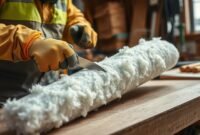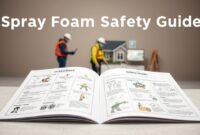Are you tired of uncomfortable temperatures in your garage? Insulating the ceiling with foam board might be the answer. It can help control the temperature, save energy, reduce noise, and even boost your home’s value. In this guide, I’ll show you how to insulate your garage ceiling with foam board. This DIY project can be very rewarding.
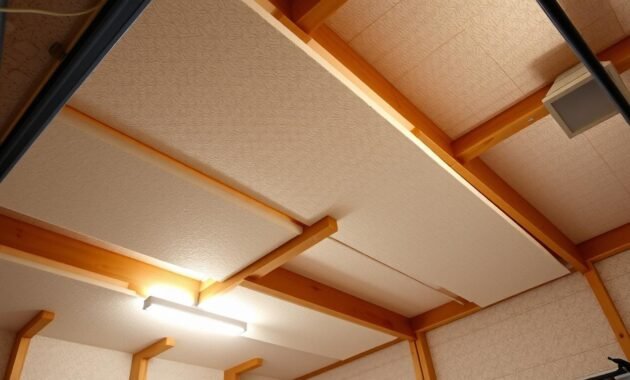
Key Takeaways
- Insulating your garage ceiling with foam board can improve energy efficiency and temperature control.
- Foam board insulation is a popular choice due to its ability to fill gaps and maintain consistent room temperatures.
- Proper installation and sealing of air leaks are key to getting the most from garage ceiling insulation.
- Knowing the different insulation materials and their R-values helps you choose wisely.
- Following safety tips and using the right tools makes the DIY installation process easier and more successful.
Read also: How to Insulate a Garage Ceiling Like a Pro
Basics of Garage Insulation
Insulating your garage right is key for a cozy and energy-saving space. Unlike living areas, garages often don’t have enough insulation. This leads to temperature swings and heat loss. To fix this, you can use materials like fiberglass, foam board, and spray foam.
Choosing the right insulation for your garage involves a few important things. The R-value, or thermal resistance, shows how well insulation blocks heat. Also, how easy it is to install and if it fits with your garage’s setup matters a lot.
Insulating garage walls is a big deal for saving energy. Adding a vapor barrier helps stop moisture and keeps insulation safe. Don’t forget to insulate the ceiling for better temperature control and to block noise. And, insulating the garage door is vital to stop heat from escaping or entering.
Good ventilation and letting in natural light are also key. They make your garage a comfortable and useful space.
Learning about garage insulation helps homeowners pick the best materials and methods. This way, they can keep their garages warm, energy-smart, and in top shape.
Types of Insulation Materials
When insulating your garage ceiling, you have several options. Each has its own benefits and drawbacks. The most common include fiberglass batts, open cell spray foam, closed cell spray foam, and cellulose insulation.
Fiberglass batts are a favorite because they’re affordable and easy to install. They have an R-value of R2.5 per inch, which is moderate. But, they can get wet and don’t seal air as well as others.
Open cell spray foam is cheaper, with an R-value of R3.5 to R4 per inch. It seals air well but might not block heat as much as closed cell spray foam.
Read also: Spray Foam vs Batt Insulation Pros and Cons
| Insulation Type | R-Value per Inch | Cost Range (240 sq ft garage) |
|---|---|---|
| Fiberglass Batts | R2.5 | $1,500 – $3,000 |
| Open Cell Spray Foam | R3.5 – R4 | $2,000 – $5,000 |
| Closed Cell Spray Foam | R6 – R7 | $3,000 – $8,000 |
| Cellulose Insulation | R3.5 – R4 | $2,000 – $4,500 |
Closed cell spray foam has a high R-value of R6 to R7 per inch. It blocks heat and moisture well. But, it’s the priciest, costing $3,000 to $8,000 for a 240 square foot garage.
Cellulose insulation, made from recycled newspapers, has an R-value of R3.5 to R4 per inch. It’s eco-friendly but can be expensive. This is because it needs a special machine to install.
Benefits of Foam Board Insulation
Foam board insulation is a top pick for garage insulation. It’s versatile and offers many benefits. These make it great for improving your garage’s energy efficiency.
Why Choose Foam Board?
Foam board insulation is top-notch for keeping heat out. It’s light, easy to work with, and has a high R-value. This means it’s perfect for your garage ceiling, keeping it comfy all year and saving on energy costs.
Understanding R-Value Standards
The R-value is key when picking insulation. It shows how well a material stops heat flow. Higher R-values mean better insulation. Knowing your local climate and building codes helps pick the right R-value for your garage.
| Insulation Material | R-Value per Inch |
|---|---|
| Expanded Polystyrene (EPS) Foam Board | 4 |
| Extruded Polystyrene (XPS) Foam Board | 5 |
| Polyisocyanurate (Polyiso) Foam Board | 6 |
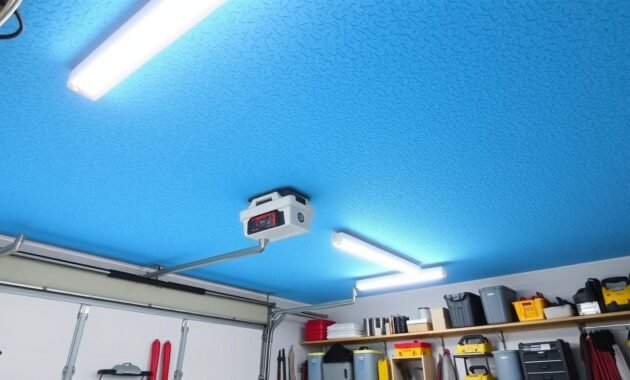
Knowing foam board’s benefits and R-value standards helps homeowners choose well. The right insulation boosts energy efficiency, comfort, and your home’s value.
Tools and Preparation for Insulation
Getting ready for your insulation project is key. You need the right tools and materials, and a well-set workspace. Planning ahead helps you avoid problems and get the best results when how to install foam board insulation ceiling or garage doors insulation.
Tools and Materials Needed
For insulating your garage ceiling with foam board, you’ll need:
- Utility knife or insulation saw
- Measuring tape
- Straight edge or level
- Notched trowel (for adhesive application)
- Foil tape or foam sealant
- Safety gear (gloves, goggles, and respirator mask)
You might also need adhesive or fasteners, depending on the foam board. Always read the instructions and have everything ready before you start.
Safety and Workspace Setup
Before starting, make sure your workspace is safe and ready. Clear it of debris and ensure good ventilation to avoid fumes. Wearing safety gear like gloves, goggles, and a mask is vital to protect yourself.
Measure carefully and cut the foam board to fit perfectly. This saves waste and boosts insulation performance. A well-organized workspace is essential for a successful garage doors insulation project.
Installing Foam Board Insulation
Installing foam board insulation in your garage ceiling is key for better energy use and comfort. By following a clear guide, you can avoid mistakes that might lessen the insulation’s impact.
Step-by-Step Installation Guide
- First, measure the space between the ceiling joists to find the right foam board size. This ensures a tight fit and blocks air leaks.
- Next, cut the foam board to size using a sharp knife or circular saw. Make sure it fits well between the joists.
- Then, apply a lot of adhesive or caulk to the foam board’s back. Press it firmly into place between the joists.
- After that, use screws or nails to hold the foam boards in place. This keeps them stable and prevents sagging.
- Lastly, seal any gaps or cracks around the foam boards with expanding foam. This stops air leaks and keeps the insulation working well.
Common Mistakes to Avoid
- Don’t leave air gaps or spaces between the foam boards and the joists. This can lower the insulation’s effectiveness.
- Also, avoid compressing the foam board. This can reduce its R-value and insulating power.
- Make sure to seal the foam boards’ edges and seams well. This prevents air leaks and moisture issues.
- Lastly, always follow building codes, like flame spread and smoke-developed index standards. This ensures safety.
By following these best practices and avoiding common mistakes, you can successfully install foam board insulation. This will improve your garage’s energy efficiency and make it more comfortable.
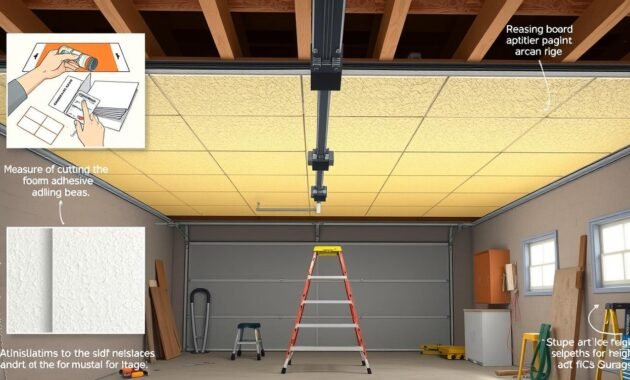
Cost and Budget for Garage Insulation
Insulating your garage can greatly improve your home’s energy use and comfort. The cost depends on your garage’s size and the insulation type. Knowing the average costs and looking for affordable options can guide you in choosing the best garage ceiling insulation.
Cost to Insulate Garage Ceiling
The cost to insulate a garage ceiling varies from $250 to $3,900. This depends on the garage size, insulation type, and ceiling finish. For a 2-car garage, the cost is usually between $800 and $5,100. Basic fiberglass insulation costs less, while spray foam is more expensive.
Budget-Friendly Tips
- Compare prices from multiple suppliers to find the best deal on insulation materials.
- Consider buying insulation in bulk, which can often result in lower per-unit costs.
- Explore the possibility of DIY installation to save on labor costs, but be mindful of safety and ensure proper installation.
- Look into any available tax credits, rebates, or other incentives that can help offset the cost of garage insulation.
- Prioritize the areas that need the most improvement, such as the garage ceiling, and tackle the project in stages if necessary.
Understanding the cost of insulating your garage ceiling and using budget-friendly tips can help. This way, you can improve your home’s energy efficiency without breaking the bank.
Read also: How Much Does it Cost to Insulate a Garage
Choosing the Best Garage Insulation
When picking insulation for your garage ceiling, you have several options. The right choice depends on R-value, moisture resistance, and how easy it is to install. While foam board insulation is popular, it’s good to compare it with fiberglass insulation and cellulose insulation.
Best Materials for Garage Ceilings
Fiberglass insulation is often used in garages. Cellulose insulation, made from recycled newspapers, is also popular for garage walls and ceilings. Rigid foam insulation is great for thin walls and garage doors, thanks to its high R-value.
Foam Board vs. Other Options
- Foam board insulation is known for its excellent insulative properties, making it a top choice for many homeowners. It can be more expensive than other options.
- Fiberglass batts or rolls are a budget-friendly alternative, with a range of R-values to suit your needs.
- Cellulose insulation is another cost-effective choice, with the added benefit of being made from recycled materials.
- Spray foam insulation is priced higher but provides superior air sealing and insulation, making it ideal for garage-to-living-space conversions.
The best insulation for your garage ceiling depends on your goals, budget, and installation needs. By comparing the pros and cons of each material, you can make a well-informed decision. This will help keep your garage comfortable and energy-efficient.
| Insulation Material | R-Value per Inch | Cost per Square Foot |
|---|---|---|
| Fiberglass Batt | R-3.2 to R-4.3 | $0.50 to $1.50 |
| Cellulose Loose-Fill | R-3.5 to R-3.8 | $0.70 to $1.20 |
| Rigid Foam Board | R-4 to R-8 | $1.00 to $2.50 |
| Spray Foam | R-3.8 to R-6.5 | $1.50 to $4.00 |
Ventilation and Moisture Control
Proper ventilation is key when insulating a garage ceiling. It stops moisture buildup and condensation problems. Rafter vents help keep air flowing, and vapor barriers manage moisture. Before you start, fix any moisture issues and seal air leaks well. This makes your insulation for garages work better.
Proper Ventilation Techniques
Good ventilation is a must in insulation. Rafter vents, placed between the attic floor and roof, let air move. This stops moisture buildup and keeps the insulation healthy.
Solving Condensation Problems
Condensation is a big problem in garages, more so in cold or humid areas. Use a vapor barrier on the warm side of insulation. It stops moisture from getting in and causing mold. Sometimes, you might need more dehumidification or ventilation to control condensation fully.
Focus on ventilation and moisture control for effective garage insulation. Fix any air leaks or moisture before starting. This way, your insulation will last longer and work better.
Additional Insulation Options
While foam board is great for insulating your garage ceiling, other options are worth looking into. Garage door insulation kits can help by reducing heat loss through the biggest opening. These kits use foil-faced panels or reflective materials to block heat.
Spray foam insulation is another choice, with two types: open cell and closed cell. Open cell foam is cheaper but has a lower R-value. Closed cell foam is pricier but offers better insulation and a tighter seal. Both can be used on garage ceilings and walls, giving better insulation than traditional methods.
Alternative Insulation Methods
- Garage Door Insulation Kits: These kits use foil-faced panels or reflective materials to reduce heat transfer through the garage door.
- Open Cell Spray Foam: This type of spray foam has a lower R-value per inch but is often more budget-friendly.
- Closed Cell Spray Foam: Closed cell spray foam provides a higher R-value and a more airtight seal, giving better insulation.
Insulating your garage can be more effective with a mix of methods. Using foam board on the ceiling and adding garage door kits or spray foam can make a big difference. This combination creates a strong thermal barrier, improving energy efficiency and comfort in your garage year-round.
Building Code and Compliance
Insulating your garage must follow local building codes and energy standards. These rules protect your insulation’s safety and performance. They can also lead to rebates or incentives. Here are the main points to consider for your project.
Meeting Insulation Standards
Start by learning about the R-value for your area. R-value shows how well insulation blocks heat. Different places have different R-value needs based on their weather. Also, check if your garage needs fire-resistant insulation.
Following these standards makes your garage more energy efficient. It also keeps your home and family safe. Understanding and meeting these requirements can save you money and give you peace of mind.
Navigating Building Code Regulations
Building codes have specific rules for insulation. They require insulation to be installed without gaps and to the right depth. It’s important to follow these rules to avoid problems or safety risks.
Some places have updated to newer versions of the International Energy Conservation Code (IECC). This might mean more insulation is needed. Working with skilled contractors and staying up-to-date on code changes can help your project meet all requirements.
By focusing on building code compliance and insulation standards, you make your garage energy efficient. This also helps keep your home safe and lasting longer. A well-insulated garage is a big improvement for insulation for garages.
Conclusion
Insulating your garage ceiling with foam board is a smart move. It boosts energy efficiency and makes your living space more comfortable. By following the right steps, you can turn your garage into a useful, stable area.
It’s important to stick to industry standards and building codes. This ensures your insulation project is safe and lasts long.
Choosing the right insulation, like fiberglass batts, spray foam, or rigid foam boards, is key. The right choice can lower your energy bills and improve comfort. Understanding each type’s benefits helps you pick the best for your needs.
Remember, safety, ventilation, and detail matter when insulating your garage. With careful planning and the right approach, you can make your garage a cozy, efficient space. This will also increase your home’s value and livability.
